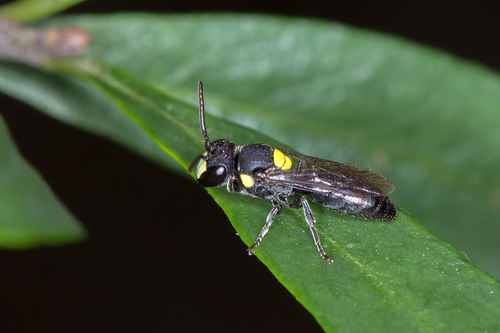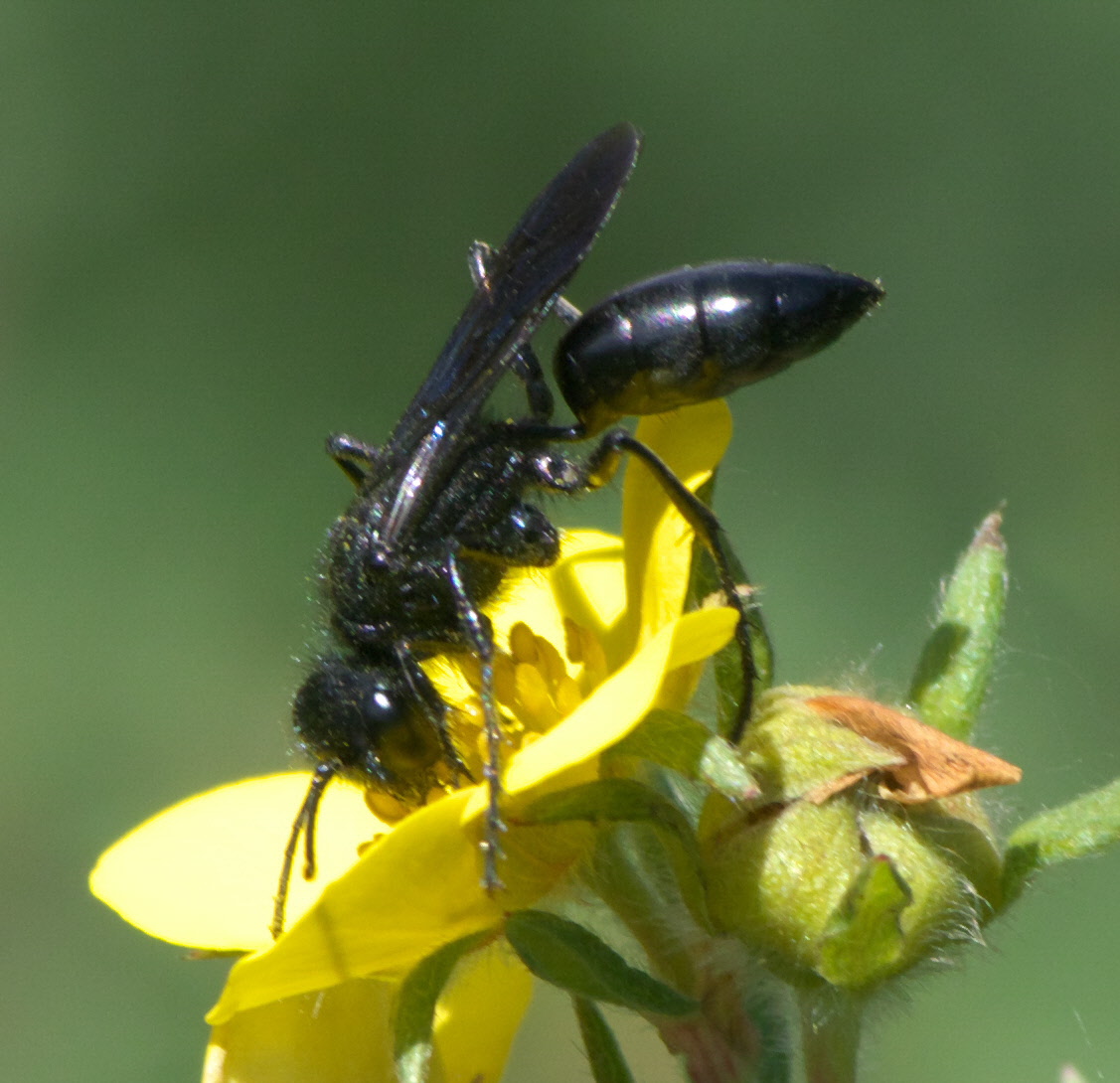|
Hylaeus Nubilosus
''Hylaeus nubilosus'' is a species of insect within the genus '' Hylaeus''. It is commonly referred to as the cloudy masked bee. Description ''Hylaeus nubilosus'' is a medium-sized (6–9 mm) masked bee with a conspicuous yellow thoracic badge in the middle of the scutellum and metanotum.Prendergast, Kit. (2017). ESTABLISHMENT OF THE EAST AUSTRALIAN MASKED BEE HYLAEUS NUBILOSUS (SMITH) (HYMENOPTERA: COLLETIDAE: HYLAEINAE) IN WESTERN AUSTRALIA. Australian Entomologist. 44. 213–218. Range Endemic to the eastern States of Australia. It is also recorded from several suburban sites in the Perth region of southwestern Western Australia. Habitat ''Hylaeus nubilosus'' prefers to nest in abandoned nests of mud-dauber wasps such as Sphecidae and potter wasps Eumeninae Potter wasps (or mason wasps), the Eumeninae, are a cosmopolitan wasp group currently considered a subfamily of Vespidae, but sometimes recognized in the past as a separate family, Eumenidae. Mud dauber wasps, which als ... [...More Info...] [...Related Items...] OR: [Wikipedia] [Google] [Baidu] |
Frederick Smith (entomologist)
Frederick Smith (30 December 1805 – 16 February 1879) was a British entomologist who worked at the zoology department of the British Museum from 1849, specialising in the Hymenoptera. Smith was born near York to William Smith and went to school at Leeds. He then studied under landscape engraver William Bernard Cooke, W.B. Cooke along with his nephew William Edward Shuckard. Together they took an interest in insects, especially the ants and bees. In 1841, following the death of William Bainbridge, he became a curator of the collections and the library of the Entomological Society of London. As an engraver he produced copies based on the works of Turner, Constable and David Roberts. He also worked with Gray arranging Hymenoptera in the British Museum. In 1849 he succeeded Edward Doubleday as a member of the zoologicy department. He then gave up his art work but produced the plates for Wollaston's ''Insecta Maderensia'' (1854) and for papers in the Transactions of the Entomologic ... [...More Info...] [...Related Items...] OR: [Wikipedia] [Google] [Baidu] |
Species
A species () is often defined as the largest group of organisms in which any two individuals of the appropriate sexes or mating types can produce fertile offspring, typically by sexual reproduction. It is the basic unit of Taxonomy (biology), classification and a taxonomic rank of an organism, as well as a unit of biodiversity. Other ways of defining species include their karyotype, DNA sequence, morphology (biology), morphology, behaviour, or ecological niche. In addition, palaeontologists use the concept of the chronospecies since fossil reproduction cannot be examined. The most recent rigorous estimate for the total number of species of eukaryotes is between 8 and 8.7 million. About 14% of these had been described by 2011. All species (except viruses) are given a binomial nomenclature, two-part name, a "binomen". The first part of a binomen is the name of a genus to which the species belongs. The second part is called the specific name (zoology), specific name or the specific ... [...More Info...] [...Related Items...] OR: [Wikipedia] [Google] [Baidu] |
Genus
Genus (; : genera ) is a taxonomic rank above species and below family (taxonomy), family as used in the biological classification of extant taxon, living and fossil organisms as well as Virus classification#ICTV classification, viruses. In binomial nomenclature, the genus name forms the first part of the binomial species name for each species within the genus. :E.g. ''Panthera leo'' (lion) and ''Panthera onca'' (jaguar) are two species within the genus ''Panthera''. ''Panthera'' is a genus within the family Felidae. The composition of a genus is determined by taxonomy (biology), taxonomists. The standards for genus classification are not strictly codified, so different authorities often produce different classifications for genera. There are some general practices used, however, including the idea that a newly defined genus should fulfill these three criteria to be descriptively useful: # monophyly – all descendants of an ancestral taxon are grouped together (i.e. Phylogeneti ... [...More Info...] [...Related Items...] OR: [Wikipedia] [Google] [Baidu] |
Hylaeus (bee)
''Hylaeus'' is a large (over 500 species) and diverse cosmopolitan genus within the bee family Colletidae. This genus is also known as the yellow-faced bees or masked bees. This genus is the only truly globally distributed colletid, occurring on all continents except Antarctica. Description The genus of bees consists of generally small, black-and-yellow or black-and-white wasp-like species. The resemblance to wasps is enhanced by the absence of a scopa, which is atypical among bees. The body form of this genus is described as hylaeiform (slender); the hairs inconspicuous without magnification; and scopa inconspicuous or absent. Males have an intermediate glossal shape with a small to distinct median apical glossal point. ''Hylaeus'' carry pollen in the crop, rather than externally, and regurgitate it into the cell where it will be used as larval food. Like most colletids, the liquid provisions are sealed inside a membranous cellophane-like cell lining. Nests are typically made ... [...More Info...] [...Related Items...] OR: [Wikipedia] [Google] [Baidu] |
Sphecidae
The Sphecidae are a Cosmopolitan distribution, cosmopolitan family of wasps of the suborder Apocrita that includes Ammophilinae, sand wasps, mud daubers, and other thread-waisted wasps. The name Sphecidae was formerly given to a much larger grouping of wasps. This was found to be paraphyletic, so most of the old subfamilies have been moved to the Crabronidae. Biology The biology of the Sphecidae, even under the restricted definition, is still fairly diverse; some sceliphrines even display rudimentary forms of sociality, and some sphecines rear multiple larvae in a single large brood cell. Many nest in pre-existing cavities, or dig simple burrows in the soil, but some species construct free-standing nests of mud and even (in one genus) resin. All are predatory and parasitoidal, but the type of prey ranges from spiders to various dictyopterans, orthopteroids and larvae of either Lepidoptera or other Hymenoptera; the vast majority practice mass provisioning, providing all the pr ... [...More Info...] [...Related Items...] OR: [Wikipedia] [Google] [Baidu] |
Eumeninae
Potter wasps (or mason wasps), the Eumeninae, are a cosmopolitan wasp group currently considered a subfamily of Vespidae, but sometimes recognized in the past as a separate family, Eumenidae. Mud dauber wasps, which also build their nests with mud, are in the families Sphecidae and Crabronidae and not discussed here. Recognition Most eumenine species are black or brown, and commonly marked with strikingly contrasting patterns of yellow, white, orange, or red (or combinations thereof), but some species, mostly from tropical regions, show faint to strong blue or green metallic highlights in the background colors. Like most vespids, their wings are folded longitudinally at rest. They are particularly recognized by the following combination of characteristics: # a posterolateral projection known as a parategula on both sides of the mesoscutum; # tarsal claws cleft; # hind coxae with a longitudinal dorsal carina or folding, often developed into a lobe or tooth, and; # fore wi ... [...More Info...] [...Related Items...] OR: [Wikipedia] [Google] [Baidu] |
Insects Described In 1853
Insects (from Latin ') are hexapod invertebrates of the class Insecta. They are the largest group within the arthropod phylum. Insects have a chitinous exoskeleton, a three-part body (head, thorax and abdomen), three pairs of jointed legs, compound eyes, and a pair of antennae. Insects are the most diverse group of animals, with more than a million described species; they represent more than half of all animal species. The insect nervous system consists of a brain and a ventral nerve cord. Most insects reproduce by laying eggs. Insects breathe air through a system of paired openings along their sides, connected to small tubes that take air directly to the tissues. The blood therefore does not carry oxygen; it is only partly contained in vessels, and some circulates in an open hemocoel. Insect vision is mainly through their compound eyes, with additional small ocelli. Many insects can hear, using tympanal organs, which may be on the legs or other parts of the body. The ... [...More Info...] [...Related Items...] OR: [Wikipedia] [Google] [Baidu] |
Colletidae
The Colletidae are a family (biology), family of bees, and are often referred to collectively as plasterer bees or polyester bees, due to the method of smoothing the walls of their nest cells with secretions applied with their mouthparts; these secretions dry into a cellophane-like lining.C. D. Michener (2007) ''The Bees of the World'', 2nd Edition, pg. 133, Johns Hopkins University Press. The five subfamilies, 54 genera, and over 2000 species are all evidently solitary (with the known exception of but one species, ''Amphylaeus morosus''), though many nest in aggregations. Two of the subfamilies, Euryglossinae and Hylaeinae, lack the external pollen-carrying apparatus (the scopa (biology), scopa) that otherwise characterizes most bees, and instead carry the pollen in their crops. These groups, and most genera in this family, have liquid or semiliquid pollen masses on which the larvae develop. They can be found all over the world, but the most species live in South America and Aust ... [...More Info...] [...Related Items...] OR: [Wikipedia] [Google] [Baidu] |




